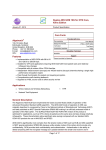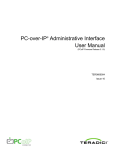Download latest PDF - Read the Docs
Transcript
fastd Documentation
Release 17+
Matthias Schiffer
June 08, 2015
Contents
1
.
.
.
.
1
1
2
9
11
2
Release notes
2.1 fastd v17 . . . . . . . . . . . . . . . . . . . . . . . . . . . . . . . . . . . . . . . . . . . . . . . . .
2.2 fastd v16 . . . . . . . . . . . . . . . . . . . . . . . . . . . . . . . . . . . . . . . . . . . . . . . . .
2.3 fastd v15 . . . . . . . . . . . . . . . . . . . . . . . . . . . . . . . . . . . . . . . . . . . . . . . . .
13
13
14
15
3
Cryptographic algorithms
3.1 ec25519 . . . . . . . . . . . . .
3.2 FHMQV-C . . . . . . . . . . .
3.3 Ciphers . . . . . . . . . . . . .
3.4 Message Authentication Codes
3.5 Method providers . . . . . . . .
.
.
.
.
.
17
17
19
21
22
22
Developer documentation
4.1 Building fastd . . . . . . . . . . . . . . . . . . . . . . . . . . . . . . . . . . . . . . . . . . . . . .
4.2 Protocol specification . . . . . . . . . . . . . . . . . . . . . . . . . . . . . . . . . . . . . . . . . .
25
25
26
4
User manual
1.1 Command line options . . . . . . . .
1.2 Configuration file format . . . . . . .
1.3 Encryption & authentication methods
1.4 MTU configuration . . . . . . . . . .
Bibliography
.
.
.
.
.
.
.
.
.
.
.
.
.
.
.
.
.
.
.
.
.
.
.
.
.
.
.
.
.
.
.
.
.
.
.
.
.
.
.
.
.
.
.
.
.
.
.
.
.
.
.
.
.
.
.
.
.
.
.
.
.
.
.
.
.
.
.
.
.
.
.
.
.
.
.
.
.
.
.
.
.
.
.
.
.
.
.
.
.
.
.
.
.
.
.
.
.
.
.
.
.
.
.
.
.
.
.
.
.
.
.
.
.
.
.
.
.
.
.
.
.
.
.
.
.
.
.
.
.
.
.
.
.
.
.
.
.
.
.
.
.
.
.
.
.
.
.
.
.
.
.
.
.
.
.
.
.
.
.
.
.
.
.
.
.
.
.
.
.
.
.
.
.
.
.
.
.
.
.
.
.
.
.
.
.
.
.
.
.
.
.
.
.
.
.
.
.
.
.
.
.
.
.
.
.
.
.
.
.
.
.
.
.
.
.
.
.
.
.
.
.
.
.
.
.
.
.
.
.
.
.
.
.
.
.
.
.
.
.
.
.
.
.
.
.
.
.
.
.
.
.
.
.
.
.
.
.
.
.
.
.
.
.
.
.
.
.
.
.
.
.
.
.
.
.
.
.
.
.
.
.
.
.
.
.
.
.
.
.
.
.
.
.
.
.
.
.
.
.
.
.
.
.
.
.
.
.
.
.
.
.
.
31
i
ii
CHAPTER 1
User manual
1.1 Command line options
Command line options and config files are parsed in order they are specified, so config files specified before other
options are overwritten by the other options, config files specified later will overwrite options specified before.
--help, -h
Shows this help text
--version, -v
Shows the fastd version
--daemon, -d
Runs fastd in the background
--pid-file <filename> Writes fastd’s PID to the specified file.
--status-socket <socket> Configures a socket to get fastd’s status.
--log-level <error|warn|info|verbose|debug|debug2> Sets the stderr log level; default is info, if no
alternative log destination ist configured. If logging to syslog or files is enabled,
the default is not to log to stderr.
--syslog-level <error|warn|info|verbose|debug|debug2> Sets the log level for syslog output; default
is not to use syslog.
--syslog-ident <ident> Sets the syslog identification; default is ‘fastd’.
--config, -c <filename> Loads a config file. - can be specified to read a config file from stdin.
--config-peer <filename> Loads a config file for a single peer. The filename will be used as the peer
name.
--config-peer-dir <dir> Loads all files from a directory as peer configs. On SIGHUP fastd will reload
peer directories.
--mode, -m <tap|tun> Sets the mode of the interface; default is TAP mode.
--interface, -i <name> Sets the name of the TUN/TAP interface to use. If not specified, default names
specified by the system will be used.
--mtu, -M <mtu>
Sets the MTU; must be at least 576. You should read MTU configuration, the
default 1500 is suboptimal in most setups.
--bind, -b <address:port> Sets the bind address. Address can be an IPv4 address or an IPv6 address,
or the keyword any. IPv6 addresses must be put in square brackets.
Default is to bind to a random port, for IPv4 and IPv6. You can specify one IPv4
and one IPv6 bind address, or both at once as any. It is currently not possible to
specify an IPv6 link-local address on the command line.
1
fastd Documentation, Release 17+
--protocol, -p <protocol> Sets the handshake protocol. Currently the only protocol available is
ec25519-fhmqvc, which provides a secure authentication of peers based on public/secret keys.
--method <method> Sets the encryption/authentication method. See the page Encryption & authentication methods for more information about the supported methods. More than
one method can be specified; the earlier you specify a method the higher is the
preference for a method, so methods speficied later will only be used if a peer
doesn’t support the first methods.
--forward
Enables forwarding of packets between clients; read the paragraph about this
option before use!
--on-pre-up <command> Sets a shell command to execute before interface creation. See the detailed
documentation below for an overview of the available environment variables.
--on-up <command> Sets a shell command to execute after interface creation. See the detailed documentation below for an overview of the available environment variables.
--on-down <command> Sets a shell command to execute before interface destruction. See the detailed
documentation below for an overview of the available environment variables.
--on-post-down <command> Sets a shell command to execute after interface destruction. See the
detailed documentation below for an overview of the available environment variables.
--on-connect <command> Sets a shell command to execute when a handshake is sent to establish a
new connection.
--on-establish <command> Sets a shell command to execute when a new connection is established.
See the detailed documentation below for an overview of the available environment variables.
--on-disestablish <command> Sets a shell command to execute when a connection is lost. See the
detailed documentation below for an overview of the available environment variables.
--on-verify <command> Sets a shell command to execute to check a connection attempt by an unknown peer. See the detailed documentation below for more information and an
overview of the available environment variables.
--verify-config
Checks the configuration and exits.
--generate-key
Generates a new keypair.
--show-key
Shows the public key corresponding to the configured secret.
--machine-readable Suppresses output of explaining text in the –show-key and –generate-key commands.
1.2 Configuration file format
1.2.1 Main configuration
Example config:
# Log warnings and errors to stderr
log level warn;
2
Chapter 1. User manual
fastd Documentation, Release 17+
# Log everything to syslog
log to syslog level debug;
# Set the interface name
interface "mesh-vpn";
# Support salsa2012+umac and null methods, prefer salsa2012+umac
method "salsa2012+umac";
method "null";
# Bind to a fixed port, IPv4 only
bind 0.0.0.0:10000;
# Secret key generated by `fastd --generate-key`
secret "78dfb05fe0aa586fb017de566b0d21398ac64032fcf1c765855f4d538cc5a357";
# Set the interface MTU for TAP mode with xsalsa20/aes128 over IPv4 with a base MTU of 1492 (PPPoE)
# (see MTU selection documentation)
mtu 1426;
# Include peers from the directory 'peers'
include peers from "peers";
bind
bind
bind
bind
] ];
bind
] ];
bind
<IPv4 address>[:<port>] [ interface "<interface>" ] [ default [ ipv4 ] ];
<IPv6 address>[:<port>] [ interface "<interface>" ] [ default [ ipv6 ] ];
any[:<port>] [ interface "<interface>" ] [ default [ ipv4|ipv6 ] ];
<IPv4 address> [port <port>] [ interface "<interface>" ] [ default [ ipv4
<IPv6 address> [port <port>] [ interface "<interface>" ] [ default [ ipv6
any [port <port>] [ interface "<interface>" ] [ default [ ipv4|ipv6 ] ];
Sets the bind address, port and possibly interface. May be specified multiple times. The keyword any
makes fastd bind to the unspecified address for both IPv4 and IPv6.
IPv6 address must be put in square brackets. It is possible to specify an IPv6 link-local address with an
interface in the usual notation (e.g. [fe80::1%eth0]).
The default option makes it the default address for outgoing connections for IPv4, IPv6 or both.
When an address without port or with port 0 is configured, a new socket with a random port will be
created for each outgoing connection. This has the side effect that the options for packet marks and
interface-specific binds (except IPv6 link-local addresses) will only work with the CAP_NET_ADMIN capability (option drop capabilities no when fastd is built with capability support, root privileges
otherwise).
Configuring no bind address at all is equivalent to the setting bind any, meaning fastd will use a random
port for each outgoing connection both for IPv4 and IPv6.
cipher "<cipher>" use "<implementation>";
Chooses a specific impelemenation for a cipher. Normally, the default setting is already the best choice.
Note that specific implementations may be unavailable on some platforms or disabled during compilation.
1.2. Configuration file format
3
fastd Documentation, Release 17+
The available ciphers and implementations are:
• aes128-ctr: AES128 in counter mode
– openssl: Use implementation from OpenSSL’s libcrypto
– nacl: Use implementation from NaCl or libsodium
• null: No encryption (for authenticated-only methods using composed_gmac)
– memcpy: Simple memcpy-based implementation
• salsa20: The Salsa20 stream cipher
– xmm: Optimized implementation for x86/amd64 CPUs with SSE2 support
– nacl: Use implementation from NaCl or libsodium
• salsa2012: The Salsa20/12 stream cipher
– xmm: Optimized implementation for x86/amd64 CPUs with SSE2 support
– nacl: Use implementation from NaCl or libsodium
drop capabilities yes|no|early;
By default, fastd switches to the configured user and/or drops its POSIX capabilities after the on up
command has been run. When drop capabilities is set to early, the on up command is run after the
privileges have been dropped, when set to no, the POSIX capabilities aren’t dropped at all (but the user is
switched after the on up command has been run nevertheless).
forward yes|no;
Enables or disabled forwarding packets between peers. Care must be taken not to create forwarding loops.
group "<group>";
Sets the group to run fastd as.
hide ip addresses yes|no;
Hides IP addresses in log output.
hide mac addresses yes|no;
Hides MAC addresses in log output.
include "<file>";
Includes another configuration file. Relative paths are interpreted relatively to the including file.
4
Chapter 1. User manual
fastd Documentation, Release 17+
include peer "<file>" [ as "<name>" ];
Includes a peer configuration (and optionally gives the peer a name).
include peers from "<dir>";
Includes each file in a directory as a peer configuration. These peers are reloaded when fastd receives a
SIGHUP signal.
interface "<name>";
Sets the name of the TUN/TAP interface to use; it will be set by the OS when no name is configured
explicitly.
log level fatal|error|warn|info|verbose|debug|debug2;
Sets the default log level, meaning syslog if there is currently a level set for syslog, and stderr otherwise.
log to stderr level fatal|error|warn|info|verbose|debug|debug2;
Sets the stderr log level. By default no log messages are printed on stderr, unless no other log destination
is configured, which causes fastd to log to stderr with level info.
log to syslog [ as "<ident>" ] [ level
fatal|error|warn|info|verbose|debug|debug2 ];
Sets the syslog log level. By default syslog isn’t used.
mac "<MAC>" use "<implementation>";
Chooses a specific impelemenation for a message authentication code. Normally, the default setting is
already the best choice. Note that specific implementations may be unavailable on some platforms or
disabled during compilation. The available MACs and implementations are:
• ghash: The MAC used by the GCM and GMAC methods
– pclmulqdq: An optimized implementation for modern x86/amd64 CPUs supporting the
PCLMULQDQ instruction
– builtin: A generic implementation
• uhash: The MAC used by the UMAC methods
– builtin: A generic implementation
method "<method>";
1.2. Configuration file format
5
fastd Documentation, Release 17+
Sets the encryption/authentication method. See the page Encryption & authentication methods for more
information about the supported methods. When multiple method statements are given, the first one has
the highest preference.
mode tap|tun;
Sets the mode of the interface; the default is TAP mode.
mtu <MTU>;
Sets the MTU; must be at least 576. You should read the page MTU configuration as the default 1500 is
suboptimal in most setups.
on
on
on
on
on
on
on
pre-up [ sync | async ] "<command>";
up [ sync | async ] "<command>";
down [ sync | async ] "<command>";
post-down [ sync | async ] "<command>";
connect [ sync | async ] "<command>";
establish [ sync | async ] "<command>";
disestablish [ sync | async ] "<command>";
Configures a shell command that is run after the interface is created, before the interface is destroyed,
when a handshake is sent to make a new connection, when a new peer connection has been established,
or after a peer connection has been lost. fastd will block until the command has finished, to long-running
processes should be started in the background.
pre-up, up, down and post-down commands are executed synchronously by default, meaning fastd will
block until the commands have finished, while the other commands are executed asynchronously by
default. This can be changed using the keywords sync and async.
The following environment variables are set by fastd for all commands:
• FASTD_PID: fastd’s PID
• INTERFACE: the interface name
• INTERFACE_MTU: the configured MTU
• LOCAL_KEY: the local public key
For on connect, on establish and on disestablish the following variables are set in addition:
• LOCAL_ADDRESS: the local IP address
• LOCAL_PORT: the local UDP port
• PEER_ADDRESS: the peer’s IP address
• PEER_PORT: the peer’s UDP port
• PEER_NAME: the peer’s name in the local configuration
• PEER_KEY: the peer’s public key
6
Chapter 1. User manual
fastd Documentation, Release 17+
on verify [ sync | async ] "<command>";
Configures a shell command that is run on connection attempts by unknown peers. The same environment
variables as in the on establish command are supplied. When the commands returns 0, the connection is
accepted, otherwise the handshake is ignored. By default, fastd ignores connections from unknown peers.
Verify commands are executed asynchronously by default. This can be changed using the keywords sync
and async.
packet mark <mark>;
Defines a packet mark to set on fastd’s packets, which can be used in an ip rule.
Marks can be specified in decimal, hexadecimal (with a leading 0x), and octal (with a leading 0).
peer "<name>" { peer configuration }
An inline peer configuration.
peer group "<name>" { configuration }
Configures a peer group.
peer limit <limit>;
Sets the maximum number of connections for the current peer group.
pmtu yes|no|auto;
Does nothing; the pmtu option is only supported for compatiblity with older versions of fastd.
protocol "<protocol>";
Sets the handshake protocol; at the moment only ec25519-fhmqvc is supported.
secret "<secret>";
Sets the secret key.
secure handshakes yes|no;
1.2. Configuration file format
7
fastd Documentation, Release 17+
fastd v11+ implements a revised handshake scheme which prevents downgrade attacks (i.e. an attacker
forcing two peers to use the least secure encryption method supported by both sides, or even halfestablishing a session with an encryption method supported by one side only). To maintain backwards
compatiblity, the old handshake is still supported when secure handshakes is set to no.
Setting this option to yes (the default) on one side is enough to ensure that a session established by two
peers has not been downgraded.
status socket "<socket>";
Configures a UNIX socket which can be used to retrieve the current state of fastd. An example script to
get the status can be found at doc/examples/status.pl in the fastd repository.
user "<user>";
Sets the user to run fastd as.
1.2.2 Peer configuration
Example config:
key "f05c6f62337d291e34f50897d89b02ae43a6a2476e2969d1c8e8104fd11c1873";
remote 192.0.2.1:10000;
remote [2001:db8::1]:10000;
remote ipv4 "fastd.example.com" port 10000;
include "<file>";
Includes another configuration file.
key "<key>";
Sets the peer’s public key.
remote
remote
remote
remote
remote
remote
<IPv4 address>:<port>;
<IPv6 address>:<port>;
[ ipv4|ipv6 ] "<hostname>":<port>;
<IPv4 address> port <port>;
<IPv6 address> port <port>;
[ ipv4|ipv6 ] "<hostname>" port <port>;
Sets the IP address or host name to connect to. If a peer doesn’t have a remote address configured,
incoming connections are accepted, but no own connection attempts will be made.
The ipv4 or ipv6 options can be used to force fastd to resolve the host name for the specified protocol
version only.
8
Chapter 1. User manual
fastd Documentation, Release 17+
Starting with fastd v9, multiple remotes may be given for a single peer. If this is the case, they will be
tried one after another. Starting with fastd v11, all addresses a given hostname resolves to are taken into
account, not only the first one. This can be use to specify alternative hostname, addresses and/or ports for
the same host; all remotes must still refer to the same peer as the public key must be unique.
float yes|no;
The float option can be used to accept connections from the peer with the specified key from other addresses that the configured ones.
1.3 Encryption & authentication methods
fastd supports various combinations of ciphers and authentication schemes using different method providers. All
ciphers, message authentication codes (MACs) and method providers can be disabled during compilation to reduce
the binary size.
See Benchmarks for an overview of the performance of the different methods.
1.3.1 Recommended methods
The method salsa2012+umac is recommended for authenticated encyption. null+salsa2012+umac is the
recommended method for authenticated-only operation.
Salsa20/12 is a stream cipher with very high speed and a very comfortable security margin. It has been chosed for the
software profile in the eSTREAM project in 2008.
UMAC is an extremely fast message authentication code which is provably secure and optimized for software implementations.
OpenWrt
Too keep the binary as small as possible, only the following methods are enabled on OpenWrt by default:
• salsa2012+gmac
• salsa2012+umac
• null+salsa2012+gmac
• null+salsa2012+umac
• null
Of these, the GMAC-based methods may be dropped in the future to further reduce the binary size, as UMAC is the
superior authentication scheme (it is faster than GMAC, provably secure and its software implementation isn’t suspect
to timing side channels).
1.3. Encryption & authentication methods
9
fastd Documentation, Release 17+
1.3.2 List of methods
Encrypted methods
Method
Method Ci- MAC
provider pher
aes128-gcm
generic- aes128-ghash
gmac
ctr
salsa20+gmac
generic- salsa20ghash
gmac
salsa2012+gmac
generic- salsa2012
ghash
gmac
aes128-ctr+umac
generic- aes128-uhash
umac
ctr
salsa20+umac
generic- salsa20uhash
umac
salsa2012+umac
generic- salsa2012
uhash
umac
aes128-ctr+poly1305
generic- aes128-none 2
poly1305 ctr
salsa20+poly1305
generic- salsa20none 1
poly1305
salsa2012+poly1305
generic- salsa2012
none 1
poly1305
Notes
1
2
2 3
,
3
3
This list is not exhaustive. It is possible to combine different ciphers for data and authentication tag encryption using
the composed-gmac and composed-umac method providers; these methods aren’t listed here as this is not very useful.
Authenticated-only methods
Method
Method
provider
null+aes128-gmac
composedgmac
null+salsa20+gmac
composedgmac
null+salsa2012+gmac
composedgmac
null+aes128-ctr+umac
composedumac
null+salsa20+umac
composedumac
null+salsa2012+umac
composedumac
CiMAC Notes
pher
aes128- ghash 2 , 4
ctr
salsa20 ghash 4
salsa2012ghash
4
aes128- uhash 2 , 4
ctr
salsa20 uhash 4
salsa2012uhash
4
1 AES is very slow without OpenSSL support. OpenSSL’s AES implementation may be suspect to cache timing side channels when no hardware
support like AES-NI is available.
2 The MAC is integrated in the method provider.
3 Poly1305 is very slow on embedded systems.
4 The cipher is used to encrypt the authentication tag only, the actual data is transmitted unencrypted.
10
Chapter 1. User manual
fastd Documentation, Release 17+
Methods without security
Method Method
provider
null null
Cipher
none
MAC Notes
none
5
Deprecated methods
Method
Method
provider
xsalsa20-poly1305
xsalsa20poly1305
Cipher
none
MAC
Notes
none
6
Since fastd v11 salsa20+poly1305 should be used instead (or even better a more performant method
like salsa2012+gmac); xsalsa20-poly1305 will be removed eventually.
1.4 MTU configuration
The default MTU of fastd is 1500. This allows briding the fastd interface in TAP mode with other interface with the
same MTU, but will usually cause fastd’s UDP packets to be fragmented. Fragmentation can lower the performance or
even cause connectivity problems when broken routers filter ICMP packets, so if possible the MTU should be chosed
small enough so that IP fragmentation can be avoided. Unlike OpenVPN, fastd doesn’t support fragmentation itself,
but relies on the IP stack to fragment packets when necessary.
1.4.1 Guidelines
• The basic overhead of a fastd packet in TUN mode over IPv4 is 39 Bytes when only null crypto is used and 52
Bytes for all other crypto methods
• TAP mode needs 14 bytes more than TUN mode
• Tunneling over IPv6 needs 20 bytes more than IPv4
1.4.2 Examples
Your base MTU is 1500 and you want to use TUN mode over IPv4 with any crypto method: Choose 1500 - 52 =
1448 bytes.
Your base MTU is 1492 (like most German DSL lines) and you want to use TAP mode over IPv4 with any crypto method:
Choose 1492 - 52 - 14 = 1426 bytes.
Conservative choice when you want to transfer IPv6 inside the tunnel: Choose 1280 Bytes (not relevant when
you use batman-adv inside the tunnel as batman-adv will take care of the inner fragmentation).
Conservative choice when you don’t know anything (but assume the base MTU is at least 1280 so IPv6 can be supported) and wa
Choose 1280 - 52 - 14 - 20 = 1194 bytes.
5 Only
6 Both
authentication of peers’ IP addresses, but no encryption or authentication of any data is provided.
the cipher and the MAC are integrated in the method provider.
1.4. MTU configuration
11
fastd Documentation, Release 17+
12
Chapter 1. User manual
CHAPTER 2
Release notes
2.1 fastd v17
2.1.1 New features
• Per-peer-group method specification
It is now possible to override the supported crypto methods per peer group.
• Connection reset via SIGUSR2
Sending a SIGUSR2 to the fastd process will reset all connections.
• Support for Android 4.1+
Contributed by Rick Lei. See doc/README-Android.md.
• Faster handshake
fastd’s handshake should now take significantly less time (about 30-50%, not regarding the network latency).
Due tue this change fastd depends on libuecc v5 (which is released together with fastd v17) now.
2.1.2 Bugfixes
• Removed broken pmtu option
The pmtu option was changed into a no-op (and fastd’s behaviour was changed to what was pmtu no before)
as fastd didn’t handle a potentially discovered smaller path MTU correctly. It will probably return in a future
version of fastd.
• Improve handling of incoming packets from many peers after restarting fastd
fastd will generate only one handshake per peer every 15 seconds now instead of one handshake per incoming
packet.
• Added a missing security check during handshake
While I don’t think this issue allowed an attacker to impersonate a legitimate peer or perform a man-in-themiddle attack, fastd did accept some weird keys (the identity point) as valid keys, which shouldn’t be possible.
• Fixed handling of severely reordered packets
While fastd is supposed to handle reordered packets up to 64 sequence numbers, a bug would cause it to drop
all older packets after a packet with a sequence number more than 64 packets in the future was received.
13
fastd Documentation, Release 17+
The “verification failed” message has been downgraded from the “verbose” to the “debug2” level as it will cause
a lot of log spam when there is extreme reordering.
• x86 uClibc workaround
A workaround has been added for systems without or with broken epoll_pwait libc wrappers. One libc with
such a broken wrapper is the uClibc version used in OpenWrt on x86, which made fastd fail on OpenWrt x86
systems.
• Only send packets from configured bind addresses
When a configuration file contains only an IPv4 bind address and fastd tried to connect to an IPv6 remote
address, it would use a random source port instead of falling back to IPv4 (and vice-versa).
The behaviour without any bind addresses in the configuration hasn’t been changed.
2.1.3 Other changes
• Better debug messages
The sender’s public key will now be printed with more messages regarding handshake issues.
• New handshake format
Some parts of the handshake had been submitted as little endian for historical reasons. As the normal network
byte order is big endian, support for a new handshake format using big endian has been added.
fastd will continue to send its handshake the old format for the next versions to maintain compatiblity, but it does
also understand the new format and will thus also work with future fastd versions which use the new handshake.
• MTU mismatch is fatal
fastd will now refuse to perform a handshake instead of just printing a warning when its configured MTU doesn’t
match the peer’s one. Such a configuration is always broken and will lead to issues with big packets.
2.2 fastd v16
2.2.1 Bugfixes
• Fix segmentation fault after peers with static IP addresses have been loaded
• Fix segmentation fault when status sockets are used with unnamed peers (e.g. peers authenticated by a on-verify
handler)
2.2.2 Other changes
• The JSON output of the status sockets has changed
To fix using the status socket with peers without names or with duplicate names, the peers’ public keys are now
use as the keys in the JSON object.
14
Chapter 2. Release notes
fastd Documentation, Release 17+
2.3 fastd v15
2.3.1 New features
• New message authentication code UMAC
The new message authentication code UMAC provides very high security with much higher performance than
the old GMAC methods. “salsa2012+umac” and “null+salsa2012+umac” are the new recommended methods
for authenticated encryption and authenticated-only operation.
• Status socket
A unix socket can be configured with the new status socket option. fastd will dump its current state as JSON
on every connection on this socket; this status output is much more detailed than the old SIGUSR1 output.
SIGUSR1 is ignored now.
To compile fastd with status socket support, libjson-c is required. An example script to get the status can be
found at doc/examples/status.pl.
• MacOS X support
fastd should now also run on recent versions of MacOS X. The inofficial TUN/TAP driver is required for this.
• New Sphinx-based documentation
• Fix warnings with CMake 3.0
• OpenWrt: allow setting on-connect, on-verify, on-establish... hooks via UCI
• OpenWrt: allow specifying bind interfaces in UCI
2.3.2 Bugfixes
• Signal handling improvements
This should fix an issue where asynchronous handler scripts would be left as zombie processes occasionally.
• Config check fixes in TUN mode
For some configuration mistakes, fastd would segfault instead of printing an error message.
2.3.3 Other changes
• Nicer error messages for common configuration mismatches like having no common methods
• When no port is given in a bind directive, a new random port will be chosen now for every new connection
attempt (like it was already done when no bind address was configured at all)
This allows setting additional bind options like interface binds without setting a static port.
• The peer hashtable is now grown dynamically to reduce memory usage for small numbers of peers and improve
performance for huge numbers of peers
• Major refactoring: the internal peer and peer config structs have been merged
• Internally, int64 timestamps in milliseconds are now used always instead of struct timespec
Milliseconds resolution and int64 range is completely sufficient, and many parts of the code have become
simpler due to this change.
2.3. fastd v15
15
fastd Documentation, Release 17+
16
Chapter 2. Release notes
CHAPTER 3
Cryptographic algorithms
3.1 ec25519
3.1.1 Twisted Edwards curves
In general, a twisted Edwards curve is a mathematical group on the points satisfying an equation of the form
𝑎𝑥2 + 𝑦 2 = 1 + 𝑑𝑥2 𝑦 2
For purposes of cryptography the curve is defined on a finite field.
The corresponding group law is
(︂
(𝑥1 , 𝑦1 ) + (𝑥2 , 𝑦2 ) =
𝑥1 𝑦2 + 𝑦1 𝑥2 𝑦1 𝑦2 − 𝑎𝑥1 𝑥2
,
1 + 𝑑𝑥1 𝑥2 𝑦1 𝑦2 1 − 𝑑𝑥1 𝑥2 𝑦1 𝑦2
)︂
For further information on twisted Edwards curves see [BBJ+08].
Extended coordinate representation
Representing a curve point as an coordinate pair (𝑥, 𝑦) is rather inconvenient for calculations on points as reciprocation is a very expensive operation. [HWCD08] specifies an alternative representation: the extended coordinate
representation, which stores a point as a tuple of four coodinates 𝑋, 𝑌 , 𝑍 and 𝑇 , satisfying the following equations:
𝑥=
𝑋
𝑍
𝑦=
𝑌
𝑍
𝑥·𝑦 =
𝑇
𝑍
By storing the denominator of the fractions as Z, consequent group operations can be performed without having to
compute reciprocals until a canonical representation is needed again. The additional value T is used to speed up some
operations.
The extended coordinate representation of twisted Edwards curves allows very efficient strongly unified addition; the
term strongly unified addition denotes that the implementation of the addition operation can be used to double a point
as well, so the special case of adding a point to itself doesn’t have to be implemented specifically.
As the data of the Explicit-Formulas Database [EFD] suggests, the extended coordinate representation of twisted
Edwards curves allows strongly unified addition with the least number of operations of all similar curve types and
representations in the database (i. e. 9 multiplications), which is the principal reason a twisted Edwards curve has
been chosen for fastd’s handshake.
17
fastd Documentation, Release 17+
Point compression
As the points of an elliptic curve satisfy a curve equation, it is possible to transform the coordinates of a point into a
more compact representation for transmission or storage. The twisted Edwards curve equation can be transformed to:
𝑦2 =
1 − 𝑎𝑥2
1 − 𝑑𝑥2
As one can easily see, there are at most two possible 𝑦 values for each value of 𝑥 (this rule also holds when the elliptic
curve is defined over a finite field), thus one bit is enough to distinguish between the two values.
For the curve used by fastd this means: as it is defined over a field with the cardinality 2255 − 19, 255 bit are necessary
to store a coordinate. Point compression allows to conveniently pack the 255 bit 𝑥 coordinate with the least significant
bit of the 𝑦 coordinate into a 256 bit representation.
Even though this optimization is quite obvious, it was protected by US patent 6,141,420 ([VMA00]), which chould
have complicated the operation of fastd when subject to the US patent law. Fortunately, the patent has expired on 29
July 2014.
3.1.2 The curve used by ec25519
The curve used by ec25519 is based on Curve25519 (see [Ber06]).
Curve25519 uses a Montgomery curve in a reduced representation, which allows very fast scalar multiplication, but
makes it impossible to perform simple additions on curve points. Therefore an equivalent twisted Edwards curve is
used for fastd.
Curve25519 is defined by the following equation:
𝑣 2 = 𝑢3 + 486662𝑢2 + 𝑢
over the prime field 𝐹𝑝 for the prime 𝑝 = 2255 − 19.
[BBJ+08] states that for all Montgomery curves
𝐵𝑣 2 = 𝑢3 + 𝐴𝑢2 + 𝑢
with 𝐴 ∈ 𝐹𝑝 ∖ {−2, 2} and 𝐵 ∈ 𝐹𝑝 ∖ {0} there is a birationally equivalent twisted Edwards curve
𝑎𝑥2 + 𝑦 2 = 1 + 𝑑𝑥2 𝑦 2 with 𝑎 =
𝐴−2
𝐴+2
and 𝑑 =
,
𝐵
𝐵
thus leading to the following curve equation:
486664𝑥2 + 𝑦 2 = 1 + 486660𝑥2 𝑦 2
Generator point
Curve25519 uses a point with
𝑢=9
as its generator; the 𝑣 coordinate is not specified as it is not needed by the algorithm.
The two possible 𝑣 coordinates are:
𝑣1 = 0x20ae19a1b8a086b4e01edd2c7748d14c923d4d7e6d7c61b229e9c5a27eced3d9
𝑣2 = 0x5f51e65e475f794b1fe122d388b72eb36dc2b28192839e4dd6163a5d81312c14
18
Chapter 3. Cryptographic algorithms
fastd Documentation, Release 17+
Out of (𝑢, 𝑣1 ) and (𝑢, 𝑣2 ), the point (𝑢, 𝑣1 ) has been arbitrarily chosen to be used in fastd; using the equivalence
between Montgomery and twisted Edwards curves given by [BBJ+08]
𝑢
𝑣
𝑢−1
𝑦=
𝑢+1
𝑥=
this leads to the coordinates
𝑥 = 0x547c4350219f5e19dd26a3d6668b74346a8eb726eb2396e1228cfa397ffe6bd4
𝑦 = 0x6666666666666666666666666666666666666666666666666666666666666658
which specify the generator point 𝐺 that is used by fastd’s ec25519-fhmqvc. Like (𝑢, 𝑣1 ) on the Montgomery
curve, the point 𝐺 = (𝑥, 𝑦) on the twisted Edwards curve has the order
|𝐺| = 2252 + 27742317777372353535851937790883648493
3.1.3 Implementation
The elliptic curve operations used by fastd have been implemented as a reusable library, libuecc, which is developed
together with fastd. Large portions of the implementation, especially arithmetic modulo 2255 − 19, haven been taken
from the original Curve25519 implementation, which has been released in to the public domain by its author D. J.
Bernstein.
Like in the Curve25519 implementation, great care has been taken to ensure that there are no data-dependent branches
or array accesses, thus making libuecc resistant to timing attacks.
3.1.4 Bibliography
3.2 FHMQV-C
FHMQV (Fully Hashed Menezes-Qu-Vanstone) is an extended, implicitly authenticated Diffie-Hellman key exchange
which has been specified in [SEB09], correcting issues found in the earlier MQV ([LMQ+98]) and Hashed MQV
([Kra05]) algorithms. It should be noted that proof of security provided by [SEB09] was recently found to be faulty
in [LSW+14]; nevertheless it is very unlikely that this has an impact on the security of the algorithm in practise.
The modified algorithm FHMQV-C specified in the same document also provides Perfect Forward Secrecy (PFS),
which isn’t the case for the simple FHMQV algorithm.
Like all MQV protocols, Alice and Bob have two key pairs each in FHMQV-C:
ˆ for Bob)
• A long term key pair (called 𝑎 and 𝐴ˆ for Alice, 𝑏 and 𝐵
Alice and Bob must know each other’s long term public keys in advance, as they are used to authenticate
themselves against each other.
• A handshake key pair (called 𝑥 and 𝑋 for Alice, 𝑦 and 𝑌 for Bob) generated randomly for each handshake
The algorithm further makes use of some arbitrary cryptographic hash and MAC functions:
¯ A cryptographic hash function with an output half the length of the secret keys
• 𝐻:
• MAC: A message authentication code (keyed hash) function
• KDF1 : A key derivation function with an output that can be used as key for the MAC function
• KDF2 : A key derivation function with an output with the desired length of the shared session key
3.2. FHMQV-C
19
fastd Documentation, Release 17+
The following description of the protocol has been directly taken from [SEB09] with only minor formal changes.
Upper case letter denote group elements here, lower case letter scalars; 𝒢 * is the subgroup generated by 𝐺 and 𝑞 is the
cardinality of 𝒢 * .
3.2.1 Protocol specification
1. The initiator Alice does the following:
(a) Choose 𝑥 ∈ [1, 𝑞 − 1] and compute 𝑋 = 𝑥𝐺.
ˆ 𝐵,
ˆ 𝑋) to Bob.
(b) Send (𝐴,
ˆ 𝐵,
ˆ 𝑋) Bob does the following:
2. At the receipt of (𝐴,
(a) Verify that 𝑋 ∈ 𝒢 * .
(b) Choose 𝑦 ∈ [1, 𝑞 − 1], compute 𝑌 = 𝑦𝐺.
¯
ˆ 𝐵)
ˆ and 𝑒 = 𝐻(𝑌,
¯
ˆ 𝐵).
ˆ
(c) Compute 𝑑 = 𝐻(𝑋,
𝑌, 𝐴,
𝑋, 𝐴,
(d) Compute 𝑠𝐵 = 𝑦 + 𝑒𝑏 mod 𝑞, 𝜎𝐵 = 𝑠𝐵 (𝑋 + 𝑑𝐴).
ˆ 𝐵,
ˆ 𝑋, 𝑌 ) and 𝑡𝐵 = MAC𝐾 (𝐵,
ˆ 𝑌 ).
(e) Compute 𝐾1 = KDF1 (𝜎𝐵 , 𝐴,
1
ˆ 𝐴,
ˆ 𝑌, 𝑡𝐵 ) to Alice.
(f) Send (𝐵,
ˆ 𝐴,
ˆ 𝑌, 𝑡𝐵 ) Alice does the following:
3. At the receipt of (𝐵,
1. Verify that 𝑌 ∈ 𝒢 * .
¯
ˆ 𝐵)
ˆ and 𝑒 = 𝐻(𝑌,
¯
ˆ 𝐵).
ˆ
2. Compute 𝑑 = 𝐻(𝑋,
𝑌, 𝐴,
𝑋, 𝐴,
3. Compute 𝑠𝐴 = 𝑥 + 𝑑𝑎 mod 𝑞, 𝜎𝐴 = 𝑠𝐴 (𝑌 + 𝑒𝐵).
ˆ 𝐵,
ˆ 𝑋, 𝑌 ).
4. Compute 𝐾1 = KDF1 (𝜎𝐴 , 𝐴,
ˆ 𝑌 ).
5. Verify that 𝑡𝐵 = MAC𝐾1 (𝐵,
ˆ 𝑋).
6. Compute 𝑡𝐴 = MAC𝐾1 (𝐴,
7. Send 𝑡𝐴 to Bob.
ˆ 𝐵,
ˆ 𝑋, 𝑌 ).
8. Compute 𝐾2 = KDF2 (𝜎𝐴 , 𝐴,
4. At the receipt of 𝑡𝐴 , Bob does the following:
ˆ 𝑋).
(a) Verify that 𝑡𝐴 = MAC𝐾1 (𝐴,
ˆ 𝐵,
ˆ 𝑋, 𝑌 ).
(b) Compute 𝐾2 = KDF2 (𝜎𝐴 , 𝐴,
5. The shared session key is 𝐾2 .
The third message allows Bob to ensure that he is actually communicating with Alice before the handshake is completed and thus prevents the attack on PFS described in [Kra05] that affects all 2-message key exchange protocols.
3.2.2 Usage in fastd
fastd performs the FHMQV-C key exchange on the group specified in ec25519.
20
Chapter 3. Cryptographic algorithms
fastd Documentation, Release 17+
FHMQV-C makes use of several cryptographic hash and key derivation functions that are not given in the specification.
fastd uses the following definitions for these functions:
ˆ 𝐴)
ˆ
𝑑|𝑒 = SHA256(𝑌 |𝑋|𝐵|
ˆ 𝐵,
ˆ 𝑋, 𝑌 ) = HKDF-SHA256(0x0032 , 𝜎, 𝐴|
ˆ 𝐵|𝑋|𝑌,
ˆ
𝐾1 = KDF1 (𝜎, 𝐴,
32)
ˆ 𝐵,
ˆ 𝑋, 𝑌 ) = HKDF-SHA256(𝐾1 , 𝜎, 𝐴|
ˆ 𝐵|𝑋|𝑌
ˆ
𝐾2 = KDF2 (𝜎, 𝐴,
|method, *)
where 𝑉 |𝑊 designates the concatenation of the binary strings 𝑉 and 𝑊 and
HKDF(salt, IKM, info, 𝐿) = HKDF-Expand(HKDF-Extract(salt, IKM), info, 𝐿)
See [FIPS180] (SHA256), [RFC2104] (HMAC) and [RFC5869] (HKDF) for the specifications of these algorithms.
¯
As one can see, the calculation of 𝑑 and 𝑒 deviates from the FHMQV-C specification, which uses a hash function 𝐻
with half-width (127 bit in the case of ec25519-fhmqvc) output, defining 𝑑 and 𝑒 as
¯
ˆ 𝐵)
ˆ
𝑑 = 𝐻(𝑋|𝑌
|𝐴|
¯ |𝑋|𝐴|
ˆ 𝐵)
ˆ
𝑒 = 𝐻(𝑌
ˆ 𝐴)
ˆ instead and cuts it into two 128 bit pieces which are used as 𝑑
fastd uses a single 256 bit hash SHA256(𝑌 |𝑋|𝐵|
and 𝑒. This optimization allows reusing the SHA256 implementation that is already used for KDF1 and KDF2 and
saves one hash calculation.
Furthermore, starting with fastd v11 a TLV authentication tag protecting the whole handshake packet is used instead
of the values 𝑡𝐴 and 𝑡𝐵 , which verify the public keys only. To generate this tag, HMAC-SHA256(𝐾1 , ·) is applied
to a pseudo TLV record list, which is the same as the TLV record list sent in the actual handshake packet, with the
exception of the TLV authentication tag value, which is replaced by zeros. This ensures that no part of the handshake
after the initial packet has been manipulated, preventing downgrade attacks.
For the exact sequence of handshake packets see Handshake protocol.
3.2.3 Bibliography
3.3 Ciphers
Generally, all ciphers used by fastd are stream ciphers.
This means that the cipher outputs a cipher stream indistinguishable from a random byte stream which can be used to
encrypt packets of any length without a need for padding the packet site to a multiple of a block size by just XORing
the cipher stream with the packet.
3.3.1 AES128-CTR
The Advanced Encryption Standard is a widely used, highly regarded block cipher specified in [FIPS197].
In counter mode a nonce of up to 12 bytes in concatenated with a 4 byte counter; this value is encrypted with the block
cipher to compute 16 bytes of the cipher stream.
AES128 has been chosen in contrast to the stronger variants AES192 and AES256 as hardware acceleration for
AES128 is more widely available on embedded hardware. Using this acceleration hardware from userspace through
the alg_if interface of the Linux kernel is very complex though, so support for it has been removed from fastd again
(but may still be used through OpenSSL.
One issue with the AES algorithm is that it is very hard to implement in a way that is safe against cache timing attacks
(see [Ber05a] for details). Because of that fastd can make use of two different AES implementations: a very secure,
but also very slow implementation from the NaCl library, and the implementations from OpenSSL (which can either
use hardware acceleration like AES-NI, or a fast, but potentially insecure software implementation).
3.3. Ciphers
21
fastd Documentation, Release 17+
3.3.2 Salsa20(/12)
Salsa20 (see [Ber07]) is a state-of-the-art stream cipher which is very fast and very secure. In contrast to AES, it is
easily implementable without any timing side channels.
Salsa20/12 is a variant of Salsa20 which uses only 12 instead of 20 rounds to improve performance. The Salsa20/12
has been chosen for the software profile on the eSTREAM portfolio in 2011 as it has a very high throughput while
providing a very comfortable security margin.
The even more reduced variant Salsa20/8 has also been evaluated for fastd, but the performance gain has been to small
to warrant the significantly reduced security.
3.3.3 Bibliography
3.4 Message Authentication Codes
3.4.1 GHASH / Galois/Counter Mode (GCM) / GMAC
The Galois/Counter Mode is a very well-known mode of operation for block ciphers which was specified in [MV04].
GMAC is a authentication-only variant of the algorithm.
While the original specification only considers block ciphers, GCM can also be specified in terms of the Counter mode
(CTR) of the block cipher. The counter mode transforms a block cipher into a stream cipher. This allows it to replace
the block cipher by any stream cipher while preserving all security guarantees; thereforce fastd allows to use GMAC
with any supported stream cipher.
One particular issue with GCM/GMAC is that it is hard to implement in software. Usually it is implemented using
lookup table, which might exhibit cache timing side channels. This issue doesn’t affect modern x86 CPUs providing
the PCLMUL instruction, as PCLMUL allows performing carry-less multiplications without a lookup table.
3.4.2 UHASH / UMAC
The UMAC message authentication code defined in [RFC4418] is a strongly universal hash function, which is formed
by defining a universal hash function UHASH and XORing it with a pad generated by a block cipher like AES.
In fastd, the pad can be generated by any supported stream cipher, and the key derivation function specified in the RFC
has been replaced by HKDF.
The UHASH function is optimized for efficient implementation in software on 32bit CPUs. Therefore UMAC is much
more performant than GMAC, especially on embedded systems, and doesn’t exhibit any timing side channels.
3.4.3 Bibliography
3.5 Method providers
See Encryption & authentication methods for details about the method configuration and recommendations.
3.5.1 generic-gmac
The generic-gmac provider combines the GHASH message authetication code with any stream cipher, which is used
both to encrypt the data and the authentication tag.
22
Chapter 3. Cryptographic algorithms
fastd Documentation, Release 17+
After the last encrypted data block, a block containing the length of the data (in bits, big endian) is passed to the
GHASH function as defined by the GCM specification.
The method names normally have the form “<cipher>+gmac”, and “aes128-gcm” for the AES128 cipher.
3.5.2 composed-gmac
The composed-gmac provider combines the GHASH message authetication code with two stream ciphers, where the
first one is used to encrypt the data and the second one for the authentication tag. As only the authentication tag must
be encrypted, “null” can be used as the first cipher for authenticated-only methods.
After the last encrypted data block, a block with the first 8 bytes containing the length of the data (in bits, big endian)
and the other 8 bytes set to zero is passed to the GHASH function. This differs from the size block used by the
generic-gmac for historical reasons.
The method names normally have the form “<cipher>+<cipher>+gmac”, and “<cipher>+aes128-gmac” for the
AES128 cipher.
3.5.3 generic-umac
The generic-umac provider combines the UHASH message authetication code with any stream cipher, which is used
both to encrypt the data and the authentication tag.
The method names have the form “<cipher>+umac”.
3.5.4 composed-umac
The composed-umac provider combines the UHASH message authetication code with two stream ciphers, where the
first one is used to encrypt the data and the second one for the authentication tag. As only the authentication tag must
be encrypted, “null” can be used as the first cipher for authenticated-only methods.
The method names have the form “<cipher>+<cipher>+umac”.
3.5.5 generic-poly1305
The generic-umac provider combines the Poly1305 message authentication code with any stream cipher, which is
used both to encrypt the data and the authentication tag. This method was added to replace the deprecated xsalsa20poly1305 method, but may be removed as well in the long term as UMAC is generally more performant and makes
the same security guarantees.
The method names have the form “<cipher>+poly1305”.
3.5.6 xsalsa20-poly1305
The xsalsa20-poly1305 provider only provides a single method, “xsalsa20-poly1305”, which uses the “secret box”
provided by the NaCl library. It is deprecated and should be used for connections with very old fastd versions only.
3.5.7 null
The “null” method doesn’t provide any encryption or authentication.
3.5. Method providers
23
fastd Documentation, Release 17+
3.5.8 cipher-test
The cipher-test method can be used to run a cipher without any authentication. This isn’t secure and should be used
for tests and benchmarks only.
The method names have the form “<cipher>+cipher-test”.
24
Chapter 3. Cryptographic algorithms
CHAPTER 4
Developer documentation
4.1 Building fastd
4.1.1 Dependencies
• libuecc (developed together with fastd)
• libsodium or NaCl (for most crypto methods)
• libcap (Linux only; can be disabled if you don’t need POSIX capability support)
• Bison (>= 2.5)
• pkg-config
Optional:
• libssl (for fast AES implementations; OpenSSL support must be enabled during build)
4.1.2 Building
fastd uses the CMake build system. The libuecc build works the same.
# Get fastd (or use the release tarballs)
git clone git://git.universe-factory.net/fastd
# Create a build dir
mkdir fastd-build
cd fastd-build
cmake ../fastd -DCMAKE_BUILD_TYPE=RELEASE # Set DEBUG instead of RELEASE if you plan to develop on fa
# Build fastd, binary can be found in the src subdir of the build dir
make
# Install in the system
make install
CMake will fail if any of fastd’s dependencies can’t be found. The build can be configured with the ccmake tool if it
is installed (in package cmake-curses-gui on Debian).
25
fastd Documentation, Release 17+
4.1.3 CMake variables
There are a few more options besides CMAKE_BUILD_TYPE that can be given to cmake with -DVARIABLE=VALUE:
• If you have a recent enough toolchain (GCC 4.8 or higher recommended), you can enable link-time optimization
with ENABLE_LTO=ON to get slightly better optimized binaries
• By default, fastd will try to build against libsodium.
ABLE_LIBSODIUM=OFF
If you want to use NaCl instead, set EN-
• Use ENABLE_OPENSSL=ON/OFF to enable or disable compiling against OpenSSL
• If you have a toolchain without binutils plugin support (e.g. on Debian Wheezy), it is not enough to keep
ENABLE_LTO disabled, in addition CMake must be told to use the standard ar, ranlib and nm implementation
instead of the GCC-provided versions:
CMAKE_AR=/usr/bin/ar
CMAKE_RANLIB=/usr/bin/ranlib
CMAKE_NM=/usr/bin/nm
• You can see all CMake options by calling ccmake . in the build directory after running cmake. Use the t
key to toggle display between simple and advanced view and use c and then g to update the configuration after
making changes in ccmake.
4.2 Protocol specification
4.2.1 Basic protocol design
fastd uses UDP as the transport protocol for its packets. UDP has been chosen instead of raw IP packets (as they are
used by IPIP and 6in4 tunnels or IPsec) to simplify the deployment of multiple fastd instances on the same host using
different UDP ports and allow passing through common NAT routers without explicit configuration.
The first byte of the UDP payload is used to discern the different packet types used by fastd. For now only two values
for the first byte have been defined: 0x01 indicates a handshake packet, and 0x02 a data packet. All other values are
reserved for future use and must be ignored by current implementations.
4.2.2 Handshake format
For historical reasons, there are two different TLV encodings: all multi-byte values mentioned in the handshake
specification may be transmitted either in big endian or in little endian byte order. As fastd versions before v17
only understand the old little endian format, fastd will always transmit its handshake as little endian to maintain
compatiblity, but it can also understand and correctly handle the new big endian format to support future fastd versions
which will use the new format.
The initial 0x01 byte together with the next three bytes form the 4-byte handshake header; the rest of the packet
after the header consists of a list of TLV records. The second header byte is reserved and must always be 0x00; the
following two header bytes contain the length of the following TLV records in bytes encoded as Big Endian.
The following TLV records start with a 2-byte type field, followed by a 2-byte length field and the arbitrary-length
value. There is no special alignment defined for the TLV records.
26
Chapter 4. Developer documentation
fastd Documentation, Release 17+
TLV record types
Record
ID
0x0000
Value description
Format
Values
Handshake type
{1, 2, 3}
0x0001
Reply code
0x0002
Error detail
0x0003
0x0004
Flags (currently
unused)
Mode
0x0005
Protocol name
0x0006
0x0007
0x0008
0x0009
0x000c
Method name
0x000d
Version name
0x000e
Method list
0x000f
TLV authentication
tag
32-byte opaque
value
2-byte unsigned
integer
variable-length
string
variable-length
string
zero-separated
string list
32-byte opaque
value
Not used if secure handshakes are enabled
0x000b
Sender key
Recipient key
Sender handshake key
Recipient handshake
key
Authentication tag
(obsolete)
MTU
1-byte unsigned
integer
1-byte unsigned
integer
1/2-byte unsigned
integer
variable-length bit
field
1-byte unsigned
integer
variable-length
string
32-byte public key
32-byte public key
32-byte public key
32-byte public key
0x000a
{0 (success), 1 (mandatory record missing), 2
(unacceptable value)}
Record type which caused an error
So far, no values are defined
{0 (TAP mode), 1 (TUN mode)}
“ec25519-fhmqvc”
Handshake protocol
The following specification describes the current handshake as it is performed by fastd versions since v11 when secure
handshakes are enabled.
The handshake protocol consists of three packets. See also: ec25519, FHMQV-C
The following fields are sent in all three packets as different fastd versions expect them in different parts of the
handshake:
• Mode (TUN/TAP)
• MTU
• fastd version (e.g. v15)
• Protocol name (ec25519-fhmqvc)
Handshake request
The first packet of a handshake contains the following additional fields:
4.2. Protocol specification
27
fastd Documentation, Release 17+
• Handshake type (0x01)
• FHMQV-C values:
– Sender key 𝐴ˆ
ˆ
– Recipient key 𝐵
– Sender handshake key 𝑋
The recipient key may be omitted if the recipient identity is unknown because the handshake was triggered by an
unexpected data packet.
Handshake reply
The second packet of a handshake contains the following additional fields:
• Handshake type (0x02)
• Reply code (0x00)
• Method list (list of all supported methods)
• FHMQV-C values:
ˆ
– Sender key 𝐵
– Recipient key 𝐴ˆ
– Sender handshake key 𝑌
– Recipient handshake key 𝑋
– TLV authentication tag MAC𝐵
Handshake finish
The second packet of a handshake contains the following additional fields:
• Handshake type (0x03)
• Reply code (0x00)
• Method (the chosen encryption/authentication scheme)
• FHMQV-C values:
– Sender key 𝐴ˆ
ˆ
– Recipient key 𝐵
– Sender handshake key 𝑋
– Recipient handshake key 𝑌
– TLV authentication tag MAC𝐴
Handshake error
When an unacceptable handshake is received, fastd will respond with an error packet. The error packet contains the
following fields:
• Handshake type (the type of the packet that is answered plus 1)
28
Chapter 4. Developer documentation
fastd Documentation, Release 17+
• Reply code (0x01 when a record is missing from the handshake, 0x02 when a value is unacceptable)
• Error detail (the record type ID which caused the error)
4.2.3 Payload packets
The payload packet structure is defined by the methods; at the moment most methods use the same format, starting
with a 24 byte header, followed by the actual payload:
• Byte 1: Packet type (0x02)
• Byte 2: Flags (method-specific; unused, always 0x00)
• Bytes 3-8: Packet sequence number/nonce (big endian; incremented by 2 for each packet; one side of a connection uses the even sequence numbers and the other side the odd ones)
• Bytes 9-24: Authentication tag (method-specific)
The null method uses only a 1 byte header: The packet type is directly followed by the payload data.
In the legacy xsalsa20-poly1305 method, the flag and nonce fields are reversed and the nonce is in little endian
for compatiblity reasons.
4.2. Protocol specification
29
fastd Documentation, Release 17+
30
Chapter 4. Developer documentation
Bibliography
[BBJ+08] D. J. Bernstein, P. Birkner, M. Joye, T. Lange and C. Peters, “Twisted Edwards curves”, in Progress in
Cryptology—AFRICACRYPT 2008, Springer, 2008, pp. 389–405.
[Ber06] D. J. Bernstein, “Curve25519: new Diffie-Hellman speed records”, in Public Key Cryptography-PKC 2006,
Springer, 2006, pp. 207–228.
[EFD] D. J. Bernstein and T. Lange, “Explicit-Formulas Database—Genus-1 curves over large-characteristic fields”.
[Online] http://hyperelliptic.org/EFD/g1p/index.html
[HWCD08] H. Hisil, K. K.-H. Wong, G. Carter and E. Dawson, “Twisted Edwards curves revisited”, in Advances in
Cryptology—ASIACRYPT 2008, Springer, 2008, pp. 326–343.
[VMA00] S. A. Vanstone, R. C. Mullin and G. B. Agnew, “Elliptic curve encryption systems”, US Patent 6,141,420,
2000.
[FIPS180] National Institute of Standards and Technology, “Secure hash standards (SHS)”, Federal Information Processing Standard 180-4, 2012. [Online] http://csrc.nist.gov/publications/fips/fips180-4/fips-180-4.pdf
[Kra05] H. Krawczyk, “HMQV: a high-performance secure Diffie-Hellman protocol”, Cryptology ePrint Archive,
Report 2005/176, http://eprint.iacr.org/, 2005.
[LMQ+98] L. Law, A. Menezes, M. Qu, J. Solinas and S. Vanstone, “An efficient protocol for authenticated key
agreement”, Designs, Codes and Cryptography, vol. 28, pp. 361–377, 1998.
[LSW+14] S. Liu, K. Sakurai, J. Weng, F. Zhang, and Y. Zhao, “Security Model and Analysis of FHMQV, Revisited”,
in Information Security and Cryptology, pp. 255–269, Springer, 2014.
[RFC2104] H. Krawczyk, M. Bellare and R. Canetti, “HMAC: Keyed-Hashing for Message Authentication”,
RFC 2104 (Informational), Updated by RFC 6151, Internet Engineering Task Force, 1997. [Online]
http://www.ietf.org/rfc/rfc2104.txt
[RFC5869] H. Krawczyk and P. Eronen, “HMAC-based Extract-and-Expand Key Derivation Function (HKDF)”,
RFC5869 (Informational), Internet Engineering Task Force, 2010. [Online] http://www.ietf.org/rfc/rfc5869.txt
[SEB09] A. P. Sarr, P. Elbaz–Vincent and J. Bajard, “A secure and efficient authenticated Diffie–Hellman protocol”,
Cryptology ePrint Archive, Report 2009/408, http://eprint.iacr.org/, 2009.
[Ber05a] D. J. Bernstein, “Cache-timing attacks on AES”, 2005. [Online] http://cr.yp.to/antiforgery/cachetiming20050414.pdf
[Ber07] D. J. Bernstein, “The Salsa20 family of stream ciphers”, 2007. [Online] http://cr.yp.to/snuffle/salsafamily20071225.pdf
31
fastd Documentation, Release 17+
[FIPS197] National Institute of Standards and Technology, “ADVANCED ENCRYPTION STANDARD (AES)”,
Federal Information Processing Standard 197, 2001. [Online] http://csrc.nist.gov/publications/fips/fips197/fips197.pdf
[MV04] D. McGrew and J. Viega, “The Galois/counter mode of operation (GCM)”, Submission to NIST Modes of
Operation Process, 2004.
[RFC4418] T. Krovetz, “UMAC: Message Authentication Code using Universal Hashing”, RFC4418 (Informational),
Internet Engineering Task Force, 2006. [Online] http://www.ietf.org/rfc/rfc4418.txt
32
Bibliography














































